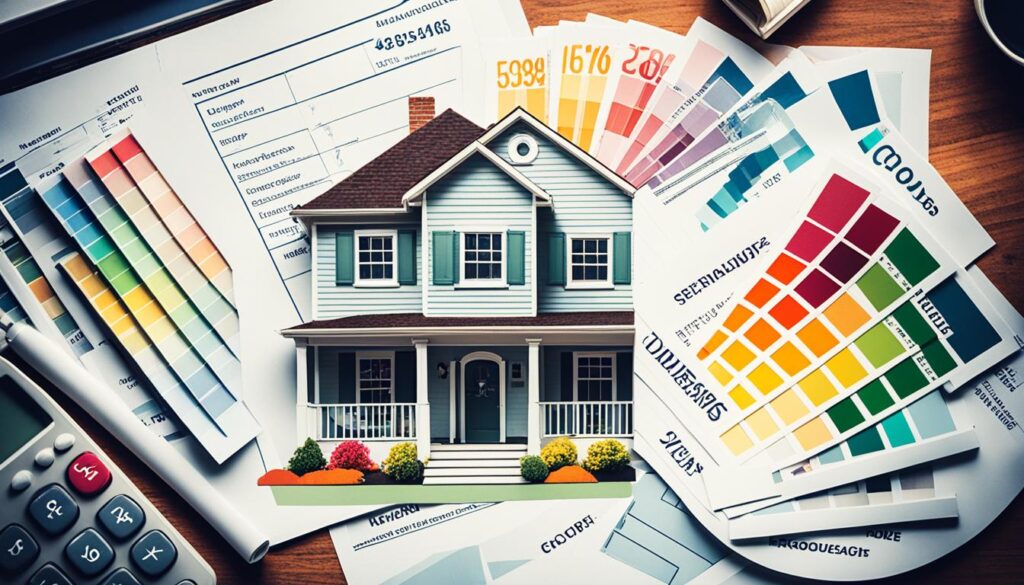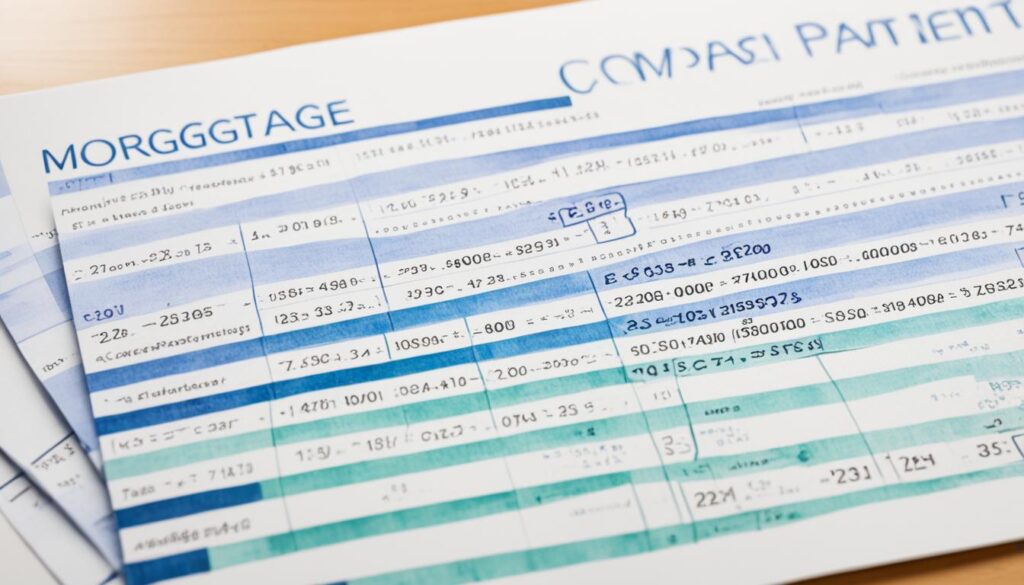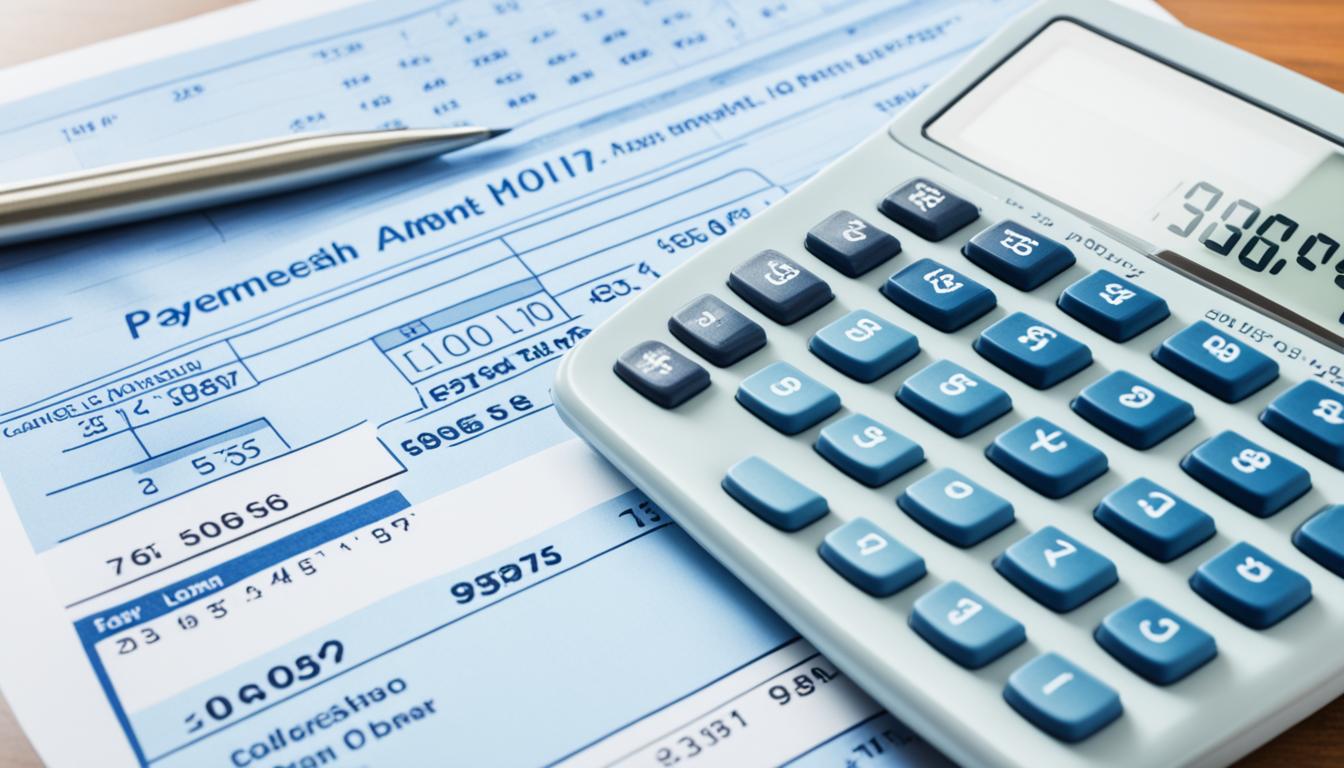Calculating mortgage payments is easy with a mortgage calculator. Here’s what you do:
- First, enter the home price or its current value if you’re refinancing.
- Next, put in your down payment either as a dollar amount or percentage.
- Then, enter the duration of your loan, for example, 30 years.
- After that, type in the interest rate you think you’ll pay.
- Don’t forget to add your ZIP code for better estimates.
- Finally, click “Update” to find out your estimated monthly mortgage payment.
Key Takeaways:
- Figuring out mortgage payments is key in buying a home.
- A mortgage calculator makes the math much easier.
- It requires info like home price, down payment, loan term, interest rate, and ZIP code.
- With one click on “Update”, you get the monthly mortgage estimate.
- It’s a great tool for smart budgeting and understanding your loan choices.
Working out mortgage payments is a big step in buying a home. With a mortgage calculator, knowing your monthly costs is simple. Just enter the house price, down payment, loan length, interest rate, and ZIP code. This lets you plan smartly and understand your financial situation well.
Understanding Typical Costs Included in a Mortgage Payment
When figuring out your mortgage payment, knowing its different costs is key. This includes principal, interest, property taxes, homeowners insurance, and mortgage insurance.
Principal
The principal is the cash you got from the lender. It’s your starting loan balance, the money you’ll pay off each month.
Interest
Interest is what the lender charges for the loan. It’s a piece of the principal, figured as a percentage, and is your borrowing cost.
Property Taxes
Property taxes help fund local services and are yearly fees on your property. Often, you pay them monthly with your mortgage.
Homeowners Insurance
Homeowners insurance safeguards your home against covered damages. This can be from fire, theft, or natural disasters. It gives you peace of mind.
Mortgage Insurance
If you put down less than 20%, you’ll need mortgage insurance. This protects the lender if you can’t pay. It’s part of your monthly mortgage.
Knowing these expenses helps you prepare your budget. It ensures you can manage all parts of your mortgage, from the principal to property taxes and beyond.

Mortgage Payment Formula
Want to figure out mortgage payments yourself? You can do it with this formula:
M = P [ i(1 + i)^n ] / [ (1 + i)^n – 1]
M: Total monthly mortgage payment
P: Principal loan amount
i: Monthly interest rate (annual rate divided by 12)
n: Number of payments (loan term in years times 12)
This formula shows what house you can buy. It does this by looking at the monthly payment. It considers the loan amount, interest rate, and how long you’ll take to pay it off. Or, you could use an online mortgage calculator for an easier way.

How a Mortgage Calculator Can Help
A mortgage calculator is a key tool for smart financial decisions when buying a home or refinancing. It helps with various mortgage aspects, making homeownership less complex. Let’s see how it can assist you:
Determine Affordability
Knowing what you can afford is crucial when buying a home. A mortgage calculator can help. It calculates monthly payments considering things like interest rates, loan terms, and extra costs such as insurance and taxes. By entering your financial details, it estimates the house within your budget, ensuring you stay within your financial means. This is crucial as you move forward in your home search.
Compare Loan Terms
The duration you take to repay your mortgage impacts your monthly payments and total interest. A mortgage calculator lets you compare various loan terms. With options such as 10, 15, 20, or 30 years, the calculator shows the differences in payments and interest. This lets you pick a loan term that fits your financial plan.
Evaluate Down Payment Scenarios
Your down payment influences your mortgage’s overall cost. A mortgage calculator helps you explore different down payment options. By changing the amount, you can see effects on your loan, interest rate, and if you can save on mortgage insurance. This helps in deciding the right down payment for your new home.
Explore Extra Payments and Interest Savings
If you can pay more towards your mortgage, a calculator can show the benefits. By adding extra payment amounts and frequencies, you’ll see how it lowers the loan balance and shortens your loan. It gives you a peek at potential interest savings, helping you make wise financial choices and pay off your mortgage sooner.
Determine Mortgage Insurance Removal
For those with less than a 20% down payment, mortgage insurance is needed. But as you pay off the loan, you might get to remove it. A mortgage calculator helps with understanding when you can drop this extra cost. This insight saves money and could reduce your monthly payments in the future.
A mortgage calculator is a powerful assistant. It looks into affordability, compares loan terms, discusses down payments, contrasts extra payments, and considers mortgage insurance removal. Using it can lead to well-informed decisions, helping to reach your homeownership dreams.

Deciding How Much House You Can Afford
The 28/36 rule guides us on housing spending. It says spend no more than 28% of your income on housing. And no more than 36% on total debt, which includes house costs.
For instance, if you earn $5,000 a month, aim for a $1,400 mortgage ($5,000 x 0.28 = $1,400). This helps you manage costs and other debts easily.
Remember, everyone’s finances differ. Speaking with a mortgage expert can offer a personalized affordability assessment.
Factors to Consider
Thinking about how much to spend on a house involves important points:
- Housing Costs: Think about your potential mortgage, property taxes, and insurance. Also, don’t forget HOA fees.
- Debt-to-Income Ratio: It looks at your debts against what you earn, mortgage included.
Using the 28/36 rule and these factors guides your budget planning. It steadies your finances and ensures other financial needs are met.

Every money choice must fit with your income, spending, and goals. While the 28/36 rule is good, your situation might need a different approach. Talking with experts can help you plan better.
How to Lower Your Monthly Mortgage Payment
If your monthly mortgage payment feels too high, you can look into ways to reduce it:
- Opt for a longer loan term: Choosing a longer stretch to pay can make each month’s bill smaller. This move spreads your payment over more time. But remember, more time means more interest cost. It’s best for those needing quick cash flow easing.
- Find a cheaper home: Searching for a home within a lower price range cuts your loan amount. This, in turn, makes your monthly payment smaller. Asking for a price cut can also shave some money off.
- Get a lower interest rate: Research and compare different mortgage rates from various lenders. A lower interest rate means a smaller monthly mortgage payment. Yet, watch out for fees that could come with making this change.
- Offer a bigger down payment: A larger upfront payment lowers your loan balance. This, in effect, lessens your month-to-month cost. It can also get you out of paying for private mortgage insurance (PMI) if you hit the 20% mark.
By choosing one or more of these paths, you might save some cash and find your mortgage bill more bearable. Always look at your finances and explore all your options carefully before deciding.
Next Steps on Getting a Mortgage
After using the mortgage calculator, your budget should be clearer. Now, let’s walk through the next steps to get a mortgage.
1. Compare Mortgage Rates
It’s vital to check out different mortgage rates. This way, you can snag a great deal and secure good terms for your loan. Make sure to look at a few lenders’ rates before you decide.
2. Pre-Qualification
Getting pre-qualified by a lender before hunting for houses is a smart move. It gives you an idea of how much you can borrow. Plus, it makes you look like a serious buyer.
3. Explore Different Loan Types
Looking into various loan types is key when getting a mortgage. There are many options, like conventional, FHA, VA, USDA, and jumbo loans. Knowing their requirements and benefits is crucial. So, do your research and talk to lenders to pick the best one for you.
By following these steps, you’re well on your way to a mortgage that fits your financial plan. Comparing rates, pre-qualifying, and checking out loan types are important steps. They will make your mortgage application process go smoothly.
| Lender | Interest Rate | Loan Type |
|---|---|---|
| Lender A | 3.5% | Conventional |
| Lender B | 4.0% | FHA |
| Lender C | 3.75% | VA |
| Lender D | 3.25% | USDA |
| Lender E | 4.5% | Jumbo |
Mortgage Calculator: Alternative Uses
A mortgage calculator isn’t just for predicting your monthly payments. It can also help you with other financial goals. Here’s how:
1. Pay off Mortgage Early
With a mortgage calculator, figure out how extra payments can shrink your loan time. Just enter the extra amount and see the impact on when you finish paying and how much you save on interest. This tool is great for planning to pay your mortgage quicker, saving you a lot of money in interest.
2. Evaluating Adjustable-Rate Mortgage (ARM) vs. Fixed-Rate Mortgage
Wondering about an adjustable-rate mortgage (ARM) versus a fixed one? A mortgage calculator can shed light. By putting in the rates and terms, you’ll see the benefits or dangers of an ARM. Use this to make a smart choice based on how your payments might change over time.
3. Getting Rid of Private Mortgage Insurance (PMI)
If you didn’t put down 20% on your house, you probably pay private mortgage insurance (PMI). A mortgage calculator helps you find out when you’ll hit 20% equity. This milestone means you can ask to stop paying PMI, lowering your monthly bills. By adding your current balance and home’s estimate value, you’ll know when PMI can go away.
Using a mortgage calculator goes beyond just figuring out monthly payments. It helps you with big financial moves like paying early, picking the right mortgage, or cutting out PMI. It’s a handy tool for anyone with a mortgage to explore different strategies.
Zillow’s Home Loan Calculator
Zillow’s home loan calculator is a great tool for figuring out mortgage payments. It gives you clear, detailed estimates. This helps you plan your budget better.
The calculator looks at many factors for your payments. It shows the main payment parts: principal and interest. You get to see exactly how much of your payment goes to these.
It also shows other costs like PMI, property taxes, and home insurance. These can change your total monthly payment. So, it’s crucial to include them in your budget.
Customizable Loan Details
Zillow’s calculator lets you adjust loan details to match your goals. You can change the down payment or interest rate. This helps you see how it affects your mortgage payments.
Using Zillow’s calculator gives you a full view of your mortgage costs. It’s great for both new homebuyers and those refinancing a loan. This tool helps you plan your finances well and feel secure in your decisions.
Terms Explained
It’s important to know key terms about mortgages. Here’s what they mean:
Loan amount
The loan amount is how much you borrow, minus what you put down. It’s the money you owe the lender.
Interest rate
The interest rate shows the cost of borrowing money from the lender. It’s a percentage. This rate affects your total interest payments.
Loan term
Loan term is how long you have to pay back the loan. It’s usually in years, like 15 to 30. More years mean lower monthly payments but higher total interest.
Mortgage insurance
Mortgage insurance is a must if you pay less than 20% down. It’s for the lender’s safety. You can stop paying it at 20% equity.
Property taxes
Property taxes are what you owe the local government each year. It’s based on your property’s value and the area’s tax rate. They’re usually in your monthly mortgage.
Homeowners insurance
Home insurance covers loss or damage to your home. It’s part of your monthly mortgage to protect your investment.
HOA fees
HOA fees are for belonging to a homeowners’ association. They help keep shared areas nice. They’re not in your mortgage, but they are an extra charge of owning a home.
Knowing these terms helps with your mortgage and home buying decisions. Thinking about the loan amount, interest rate, loan term, and extra costs like insurance and taxes lets you plan well for your new home.
Conclusion
Calculating mortgage payments is key in buying a home. Use a mortgage calculator to learn about your budget and loan terms. Knowing the costs helps you make wise choices and move smoothly through the process.
Whether you’re buying for the first time or refinancing, a mortgage calculator is useful. You can plug in the home price, down payment, term, and rate. The tool then shows your estimated monthly payment, making financial planning easier.
As you start your journey to buying a home, online mortgage calculators are there to help. They assist in making informed mortgage decisions that fit your budget. So, use a mortgage calculator now to take steps towards achieving your dream home.
FAQ
How do I calculate mortgage payments?
To figure out your monthly payments, use a mortgage calculator. You need to enter details like the home price, down payment, loan length, interest rate, and ZIP code. Or, you can use this formula: M = P [ i(1 + i)^n ] / [ (1 + i)^n – 1]. Here, M is your monthly payment, P is the loan amount, i is the rate, and n is the number of payments.
What costs are included in a mortgage payment?
Your mortgage payment includes the loan amount (principal) and the lender’s fee (interest). It also covers yearly property tax, insurance for the home, and mortgage insurance if your down payment is less than 20%.
How can a mortgage calculator help?
A mortgage calculator can show what you can afford. It helps compare loans, see different down payment options, and if making extra payments helps. It can also tell you when you can stop paying mortgage insurance.
How do I decide how much house I can afford?
Follow the 28/36 rule for a basic idea. This means spend up to 28% of your income on housing and up to 36% on all debts. But, talking to a mortgage lender for tailored advice is crucial based on your finances.
How can I lower my monthly mortgage payment?
For a lower payment, extend the loan term or find a cheaper home. Also, looking for a better interest rate or increasing your down payment can help.
What are the next steps in getting a mortgage?
First, compare rates from different lenders. Then, get pre-qualified to know your exact budget. Finally, look into various loan options to choose what’s best for you.
What are alternative uses for a mortgage calculator?
Use a mortgage calculator to see how extra payments affect your loan. You can also compare different types of loans and know when you’ll have 20% equity to drop PMI.
What is Zillow’s home loan calculator?
Zillow’s calculator breaks down your estimated monthly payment. It shows costs for principal, interest, PMI, property tax, home insurance, and HOA fees if applicable.
What are the key terms related to mortgage calculations?
Loan amount, interest rate, and loan term are important in mortgage math. Also, consider mortgage insurance, property taxes, homeowners insurance, and HOA fees for an accurate view.
How important is it to calculate mortgage payments?
Knowing your mortgage payments is key when buying a home. It ensures you can afford your dream home and helps in planning your financial future.


















